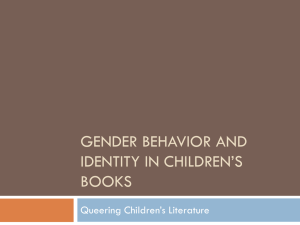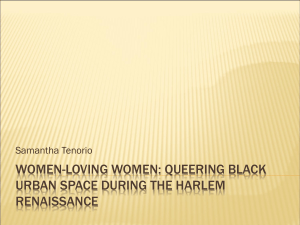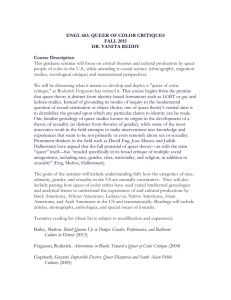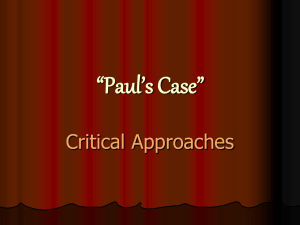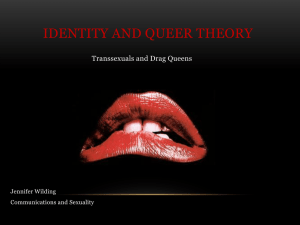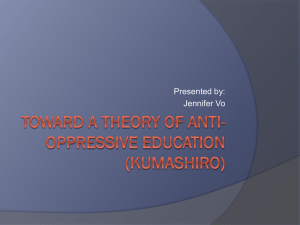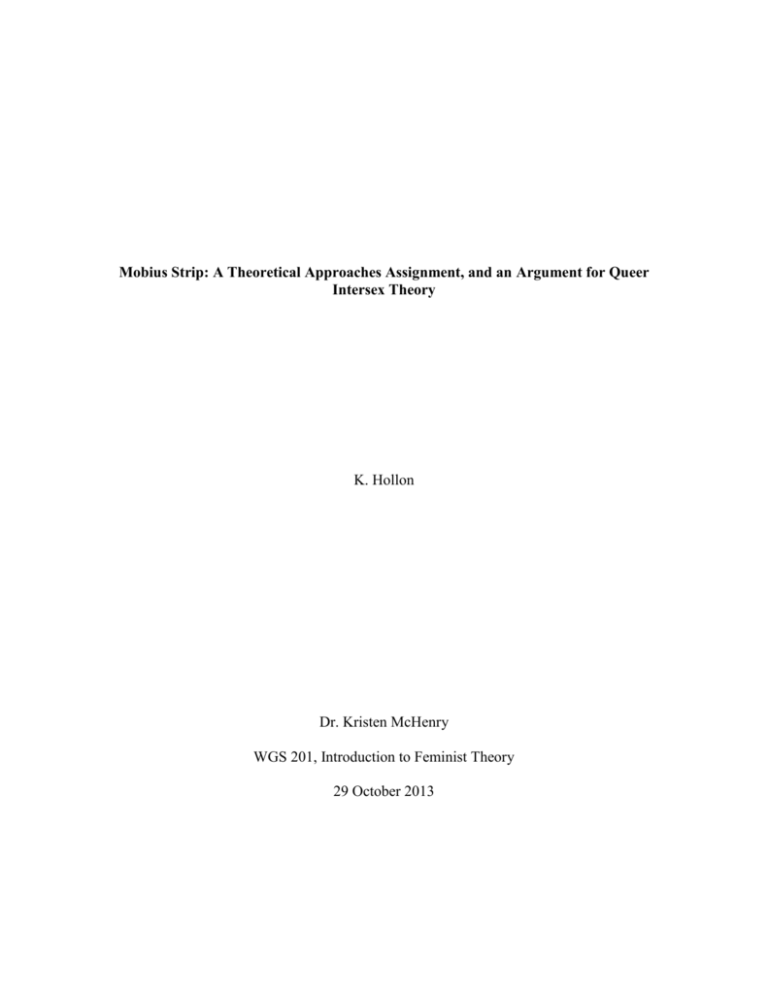
Mobius Strip: A Theoretical Approaches Assignment, and an Argument for Queer
Intersex Theory
K. Hollon
Dr. Kristen McHenry
WGS 201, Introduction to Feminist Theory
29 October 2013
Hollon
2
A contemporary theoretical perspective, queer theory is important because it
shatters the concept of human normalcy by questioning the legitimacy of social binaries
relating to gender. In regards to queer intersex theory, the myth of two distinct sexes,
called the sex binary, is the most relevant of these. Anne Fausto-Sterling’s Sexing the
Body: Gender Politics and the Construction of Intersexuality, J. David Hester’s
“Intersexes and the End of Gender: Corporeal Ethics and Postgender Bodies,” and Iain
Morland’s “What Can Queer Theory Do For Intersex?” exemplify the queer theoretical
approach in intersex theory. As a tool, the strength of queer intersex theory lies in how it
works to empower those with “ab”normal bodies, like me. Still, using the intersexed in
queer theory has a weakness: it further alienates a threatened population to its mislabeled
movement, and to the threatening mass culture.
The “I” in Intersex
I approach queer theory as a self-identified queer woman who is not lesbian,
bisexual, or transgendered who empathizes with the intersex community. Unlike many
women, I have a condition called P.C.O.S. Cysts that grow on my ovaries give me high
levels of testosterone. These hormones allow me to exhibit secondary male sex
characteristics: I can grow facial hair, I have a deeper voice and a larger body, and I
struggle with infertility. Although I am of the female sex, my body is not fully female.
Modern medicine problematizes my body by giving me a “treatable” condition, but like
many intersex individuals, I see no problem with myself as I am. For me, identifying as
queer means that I see myself as both feminine and masculine, and envision a world
without the need to quantify people by binary standards.
Hollon
3
An Essential Tenant of Queer Theory: Questioning Traditional Gender
Based on the premise that traditional biology has correctly established male and
female bodies as fundamentally different, mainstream society has assigned male and
female bodies fundamentally different genders and gender roles.
Gender is a social construct. In our society, biologically male bodies are assigned
the male gender and called “men,” and biological females are called “women.” We are
expected to accept the gender assigned to us at birth by our anatomy; it is supposed to
naturally conform to our gender identity (Hester 217). To put it plainly, mainstream
society does not distinguish between biological sex and gender (Hester 217). It expects
men to act a certain way – aggressively, assertively, rationally, independently,
intelligently – look a certain way – strong, tall, large – and, more disturbingly, internally
view themselves in these ways. Society has the same expectation of women, but expects
women to behave differently – passively, empathetically, emotionally – and look
differently – thinner (or weaker, depending on interpretation), smaller.
In turn, men and women are supposed to do different things because of their
supposedly biological/inherent differences; these gender-based/biased sets of socially
approved actions are called gender roles. Feminists often describe these roles by saying
that they relegate men and women to “separate spheres,” the outside world, of intellect
and income reserved for men, and the world of the home, childrearing, and housework
reserved for women.
Collectively, feminists refer to our society’s treatment of sex and gender as the
“sex/gender” binary, a system that fails to allow for externality concerning biological sex,
Hollon
4
sex, gender, gender identity, and gender roles by positing that only two ways of being –
male and female – are natural and true (Hester 217). In sum, Lorber explains that queer
theorists question “the twofold divisions of gender, sexuality, and even sex, undermining
the solidity of a world build on man/woman, heterosexual/homosexual, and male/female”
(Lorber 288).
Fausto-Sterling’s Sexing the Body: Gender Politics and the Construction of Intersexuality
Fausto-Sterling’s book Sexing the Body exemplifies how intersex theory employs
queer theory. As I have stated, a key tenant of queer theory involves challenging
traditional interpretations of biological sex, social gender, and their “innate” connection.
Using this principle of queer theory, Sexing the Body details how intersexed bodies
fundamentally deviate from society’s sex and gender binary.
Fausto-Sterling explains that intersexuals are first defined biologically, because
their physical differences, labeled “syndromes” or “conditions,” are recognized at birth,
due to their obvious deviation from the expected sexual norm. Medically, the intersexed
defy ideas of innate male biology and innate female biology by blending the genotype
and phenotype of both sexes. An intersexed baby, on an unaltered intersex adult, can
have testes and a vagina, ovaries, a uterus, and a penis, an enlarged clitoris, often
described as “penis-like,” or any combination of so-called male and female anatomy
(Fausto-Sterling 60-61). These people are born with different reactions to hormones or
different levels of hormones, and some have different gender genes, XXY instead of XY.
In infancy, or even in-utero, intersexed individuals are pathologized by mainstream
Hollon
5
medicine due to their difference; they are diagnosed, often with the possession of ovotestes, Keinfelter’s Syndrome, or Congenital Adrenal Hypoplaysia (Fausto-Sterling).
Many intersexed infants are subject to hundreds of childhood surgeries to their
genital area, which often remove all capacity for sexual pleasure, and cause a lifetime of
pain (Fausto-Sterling). Indicative of the queer approach, Fausto-Sterling views this forced
disfigurement as a weapon against “abnormal” bodies. She explains that “to maintain
gender divisions, we must control those bodies that are so unruly as to blur the borders.
Since intersexual quite literally embody both sexes, they weaken claims about sexual
difference” (Fausto-Sterling 4).
Overall, Fausto-Sterling’s analysis of the gender binary in Sexing the Body
embodies the use of intersex theory to support key tenants of queer theory.
Hester’s “Intersexes and the End of Gender: Corporeal Ethics and Postgender Bodies”
In his article “Intersexes and the End of Gender,” Hester provides an example of
how intersex theory can both criticize and advance queer goals. In his watershed critique,
Hester criticizes postmodern biopolitics and queer theory for constructing visions of the
body that depend too heavily on social construction, which paint anatomy as “a passive
recipient of cultural forces” (Hester 219). By re-examining historical and medical
accounts, he argues that research into intersexed bodies reveals that “hundreds of
iterations of sex” (Hester 119) – not just gender – exist, and posits for an according
expansion of queer gender focus to include sexual focus.
Still, Hester’s analysis seeks to help queer (intersex) theory understand the
intersex condition more fully, so that it can better advocate for intersex causes (Hester
Hollon
6
118-119). He believes that “the fluidity of bodily morphology upsets the system” (Hester
119), and thus shares the quintessentially queer dedication to upending not only
sex/gender binary, but the little-acknowledged sexual binary.
In sum, although Hester’s article presents a critique of queer theory, he uses its
concept of the sex/gender binary to create a new vision of biology beneficial to the
intersexed. Although Hester’s theory deviates from quintessential queer theory, he proves
how foundational queer concepts are for intersex designs.
Morland’s “What Can Queer Theory Do For Intersex?”
Using gender reassignment surgery as a case study, Morland evaluates “whether a
critique [of the intersex condition] is possible from a queer theoretical perspective on the
body” (Morland 287). Essentially, he asks the same question I have: is queer intersex
theory possible?
Morland’s answer, in short, is yes. Along with the concept of the queer sex/gender
binary, he addresses the queer concept of sexual shame in intersex terms. Because altered
intersex bodies have issues with lack of sensation, caused by surgical trauma and/or
medication, he thinks of both intersex and queer theory in terms of human discourses of
desire (Morland 288). He concludes that “desire reaches through queer and intersex
bodies alike…desire’s reach confounds the surgical process of touching atypical bodies
in order to make them sexually normal” (Morland 288, original emphasis).
In conclusion, Morland makes an important observation. Fausto-Sterling’s article
proves that queer and intersex theory agree about the sex/gender binary, while Hester’s
explains how intersex theory grows its queer partners. Still, Morland views a world in
Hollon
7
which queer theory and intersex theory form a dual approach. The perfect metaphor for
queer intersex theory is a Mobius strip: a two-dimensional object with one side.
Strength: A Personal Testimony
Ultimately, I believe that queer intersex theory allows those who defy the
sex/gender binary, like me, to find strength through connection with others and selfactualization. Oftentimes, for isolated populations, reading opens doors into other worlds;
for me, queer intersex theory helped me form friendships with other queer people. These
friendships enabled me to claim my body’s dual nature, to free it from the sex/sex binary.
At the time, my doctor was insisting that I should take the Pill to give my body a
feminine hormone balance. I did not want to for many reasons. I did not suffer ill effects
from my “different” body chemistry, and furthermore, my prior time on the Pill had
permanently lowered my testosterone levels and my libido. Interestingly, medical doctors
are aware that birth control has this effect on women with my condition (Health and
Medicine). It apparently does not concern them.
Similarly, modern medicine quantifies my state as a state of infertility. It would
regulate me to an endless cycle of consultations, medications, and procedures in attempts
to have a child; “masculine” women “aren’t built for it.” As it turns out, I got pregnant
naturally soon after my rejection of medical intervention.
Queer intersex theories, and my intersex friends, support my suspicion that these
occurrences constitute more than luck or coincidence. They are examples of policing the
intersexed body, of medicine’s attempt to create rigid, abnormal sex binaries; of its
attempt to deny our (ab)normal bodies desire. Without queer intersex theory, I never
Hollon
8
would have known that my body was a battlefield, and I never would have had the
strength to claim my body for myself. Queer intersex theory does no less than enable
people to own their bodies and their existences.
Weakness
Still, to discuss queer intersex theory’s major weakness, I return to the idea of the
sex/gender binary. It serves the normal by idealizing them – it serves society by allowing
it to maintain the stagnate status quo. However, it is evident that queer theory’s idea of
the sex/gender status quo, problematized by the intersexed, also has an inevitable victim:
the intersexed. Using them as an emblem of queer theory further alienates them to an
already hostile mainstream society, whose goal is often to rob people like me of their
physical identity. Without consulting Hester’s ideas, queer intersex theory also threatens
to reduce intersex problems to queer problems, a reduction which represents a failure to
champion the intersex cause. Thus, queer intersex theory unfortunately plays a small roll
in oppressing those it tries to liberate.
Conclusion
These weaknesses reveal that the queer ethics of intersexual choice coexist with
the ethics of social change. Queer intersex theory teaches that it is not enough that we
cease trying to change the intersexed; we need a new view of gender, but also a new view
of biology. Similarly, it reveals that it is not enough that we “tolerate” the intersexed, like
how modern, “accepting” religious fundamentals “tolerate” gays. As people in our
society and in our world, the intersexed deserve to be accepted and valued, especially
Hollon
9
considering the lessons we have the capacity to teach. Fortunately, queer intersex theory
creates a space of value for disvalued bodies; in doing so – by becoming the Mobius strip
– it truly embodies the queer movement.
Hollon
10
Works Cited
Fausto-Sterling, Anne. Sexing the Body: Gender Politics and the Construction of Sexuality. New
York, NY: Basic, 2000. Print.
Health and Medicine. "Birth control pill could cause long-term problems with
testosterone." Health & Medicine Week 23 Jan. 2006: 1364. Academic OneFile. Web. 28
Oct. 2013.
Hester, J. David. "Intersexes and the End of Gender: Corporeal Ethics and Postgender
Bodies." Journal of Gender Studies 13.3 (2004): 215-25. Academic Search Elite. Web. 28
Oct. 2013.
Lorber, Judith. "Postmodern Feminism and Queer Theory." Gender Inequality: Feminist
Theories and Politics. 5th ed. New York: Oxford UP, 2012. 284-303. Print.
Morland, Iain. "What Can Queer Theory Do For Intersex?" GLQ: A Journal of Lesbian and Gay
Studies 15.2 (2009): 285-312. Project MUSE. Web. 28 Oct. 2013.


